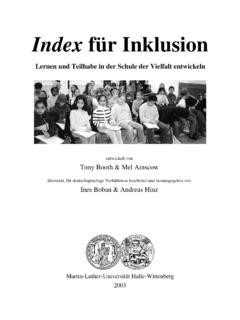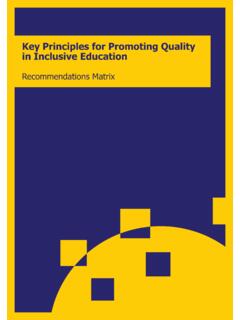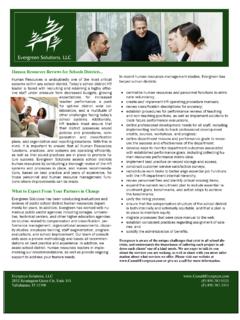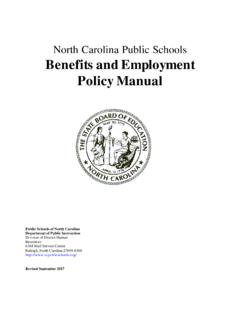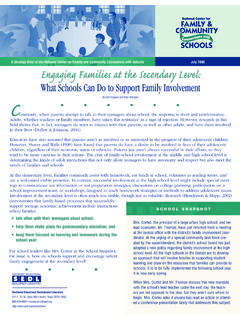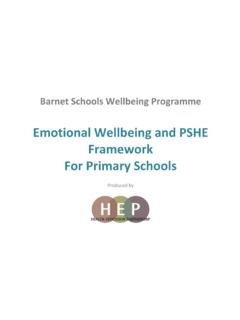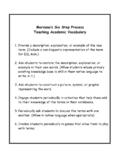Transcription of Schools for All - EENET
1 Schools for AllIncluding disabled children in educationSchools for AllIncluding disabled children in educationpracticeguidelinesProduced by:Development Dialogue TeamSave the Children 17 Grove Lane London SE5 8RD UKTEL: +44 (0) 20 7703 5400 ext. 2565 FAX: +44 (0) 20 7708 2508 can download this publication from Save the Children and partners globallydemonstrates that improvements in education quality go hand-in-handwith inclusion and access, Flexible, quality, responsive learningenvironments will benefit all children and are fundamental to includingmarginalised groups like disabled children in guidelines are primarily aimed at education staff trying todevelop inclusive education practices, focussing on including disabledchildren in this book focuses on disabled children, wehope it will be useful for developing general inclusive educationpractices. Community groups and non-governmental organisations, aswell as people working in community-based rehabilitation(CBR) andthe wider disability context, could also use these guidelines to provideinput into inclusive education the guidelines focus primarily on Schools , much of theinformation is still relevant to readers working in for AllIncluding disabled children in educationPublished bySave the Children17 Grove LaneLondon SE5 8 RDTel +44 (0)20 7703 5400 Fax +44 (0)20 7793 7630 First published 2002 Save the Children 2002 This publication is copyright, but may be reproduced by any method without fee or prior permission for teaching purposes, but not for resale.
2 For copyingin any other circumstances, prior written permission must be obtained fromthe publisher, and a fee may be Charity No. 213890 Contents 3 5 Who are these guidelines for? .. 5 What do they cover? .. 5 How are the guidelines organised?.. 6 How to use the 7 1. What is inclusive education?.. 9 What do we mean by disability ? .. 9 What is special education ?.. 10 What is the difference between integrated and inclusive education? .. 12 Building on children s development .. 14 Diagram: Changing the education system .. 15 2. Why does Save the Children UK promote the inclusion of disabled children in education?.. 16 Shifting attitudes within Save the Children 16 Save the Children UK s education 17 What are the benefits of inclusion? .. 18 Workshop tool: Education opportunities for disabled 22 3. Inclusive education and 23 The UN Convention on the Rights of the Child (1989) .. 23 The Salamanca Statement and Framework for Action (1994).
3 25 A proposed UN Convention on the Human Rights of People with 25 Workshop tool: Child rights and inclusive education .. 26 4. Addressing barriers to inclusive 27 Negative attitudes .. 27 Invisibility in the community .. 28 Invisibility in Cost .. 30 Physical access .. 31 Class 32 33 Gender discrimination .. 33 Emergency, conflict and refugee situations .. 36 2 tool: Barriers to inclusive education .. 38 5. How can we support inclusive education?.. 39 By promoting positive attitudes .. 39 By promoting inclusive learning 41 By promoting early intervention .. 42 By promoting positive role models .. 43 By supporting appropriate policy development .. 44 By supporting change of system in 45 Workshop tool: Mapping areas for support to inclusive education .. 47 6. Making it work: principles of implementing inclusive 48 Change system .. 48 Schools .. 50 Managing Schools .. 51 52 Children s participation .. 53 Community participation.
4 53 Workshop tool: Action planning .. 55 Notes .. 56 Practical tips and tools: 58 1. The physical 59 2. The learning 61 3. Observation and child 65 4. Advice and ..73 5. International 74 6. Further 78 7..82 3 Acknowledgements This document has been written by Susie Miles, in close collaboration with Shireen Miller, Ingrid Lewis and Marlies van der Kroft (Save the Children UK). The final editing was done by Emma Cain. Several people commented on the guidelines during the writing process and we would like to acknowledge their contributions and advice: Marion Molteno, Amanda Seel, Jamie Williams, Emmanuelle Abrioux, Janet Holdsworth, Hazel Jones and Mel Ainscow. 4 5 Introduction Who are these guidelines for? These guidelines are aimed at Save the Children UK (SC UK) education staff and partners who are trying to develop inclusive education practices and, in particular, the inclusion of disabled children in education.
5 They are also aimed at staff and partners working in disability, community-based rehabilitation (CBR), and other sectors, who are developing links with education programmes or who may be called upon to provide input into inclusive education work. What do they cover? These guidelines take a holistic view of the educational needs of disabled children by examining the environment in which all children learn. The central message is that mainstream learning environments can include children who may have particular learning needs due to developmental delay or impairment. Inclusive education involves child-centred (rather than curriculum-centred) learning approaches. These approaches are based on a recognition that individual children learn, and develop, in different ways and at different rates, and they seek to create a learning environment which responds to the needs of each child, including those with disabilities. The aim of the guidelines is to support a process whereby Schools become more accessible to disabled children and responsive to their Accessibility is not simply about disabled children attending school it means they should also be able to benefit from schooling, and access the curriculum.
6 At the same time, the school environment needs to be flexible and supportive so that it can respond to the The priority needs of disabled children are not special, they are basic. Disabled children need food, shelter, love and affection, protection, and education. 6 needs of individual children, rather than assuming that the child should adapt to the education provision available. The guidelines underline that improvements in quality of education go hand-in-hand with inclusion: accessible, quality, responsive learning environments will benefit all children, but they are particularly crucial for disabled children. It is important, for example, that children with hearing difficulties sit in positions where they can see best, and for teachers to use large, clear writing on blackboards and to eliminate background noise. These measures will help all children s learning, but they are critical in enabling children with hearing difficulties to access the curriculum.
7 We explore the barriers which prevent disabled children from learning, emphasising the importance of creating a barrier-free, and welcoming, environment for all children, while taking proper account of individual children s needs and abilities. We focus on the importance of challenging prevailing perceptions and attitudes to disabled children, which often present the biggest barrier to disabled children accessing mainstream education, but we also acknowledge the need for practical guidance on how to include disabled children at different levels. While the guidelines focus primarily on Schools , much of the information is still relevant to readers working in out-of- school situations. The same basic principles can be applied to both school - based, and non- school -based, educational programmes. Finally, we do not claim that developing inclusive education is an easy process. It is important to stress that this is often a demanding and challenging task for Schools , and teachers who need to challenge their own assumptions, build their capacity and develop new skills in order to include ALL pupils from the community.
8 How are the guidelines organised? The guidelines are divided into six chapters, with some practical tips and tools at the back. In Chapter 1, we define key terms such as inclusive , special and integrated education. We then outline the reasons for SC UK s support for inclusive education, in Chapter 2. Chapter 3 explores international documentation, including the UN Convention on the Rights of the Child (1989) (UNCRC) and what it says about education and disabled children. We then examine, in Chapter 4, some of the barriers we can expect to encounter when promoting and developing inclusive education. Ways in which SC UK can support the development of inclusive education are outlined in 7 Chapter 5 and, finally, in Chapter 6, we summarise the key principles and activities involved in making inclusive education a reality. Throughout the guidelines there are case studies. These are not necessarily intended to represent best practice , but to illustrate some of the issues and challenges, and give examples of some approaches used which may be helpful to other readers.
9 How to use the guidelines Workshop tools At the end of each section, you will find a workshop tool. This includes questions and activities to help you and your team think through some of the issues raised, considering how they apply in your specific context. Whilst these tools are designed to be used by teams (project officers, country/regional managers, or in joint work with partner organisations) they can also be read, and used, by individual readers. Practical tips and tools At the end of the guidelines, you will find a number of pages containing additional information which some readers may find helpful. These give advice and practical tools for including disabled children in mainstream Schools . However, these pages and the main guidelines are not intended to be used as a recipe book such an approach would not work! It is up to you how you use these pages. For example, some may be useful to photocopy for hand-outs if you hold meetings or training on inclusive education.
10 Some may simply provide you with additional information, or checklists, to expand on what you have read in the booklet. Poster This booklet also has a poster attached. SC UK s disability staff and partners initially asked us to produce a poster, with some short, snappy messages about inclusive education. We soon realised there was a need for a more in-depth resource, but have also followed the original idea and produced a poster to complement the booklet, by highlighting a few of the key messages. You may choose to display it in your office, distribute copies to other agencies, or use it during training or awareness events. Workshop Tools 1 8 The future These guidelines do not set out to be the definitive guide to inclusive education. They represent an ongoing process of learning and sharing within SC UK. We hope that they will be updated, improved, added to and re-issued. Please let us know what you think of this resource. Let us have your suggestions for improvements or additions, and tell us if you have other experiences or case studies which could illustrate particular issues.






